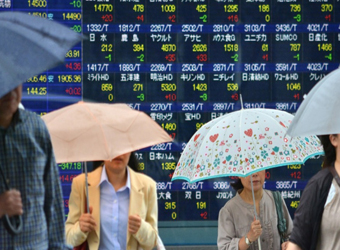South Korea’s Kospi advanced 1.15 percent, with heavily weighted technology stocks higher in the morning. Samsung Electronics rebounded 2.64 percent and SK Hynix gained 0.41 percent. Financials also traded higher in the early going.
Shipbuilders were mostly in negative territory, with Samsung Heavy down 3.17 percent. Hyundai Heavy Industries declined 1.54 percent after it reported a miss on fourth-quarter earnings on Friday after the market close.
Over in Australia, the S&P/ASX 200 slipped 0.23 percent as earnings season continued Down Under. Energy-related stocks were down 0.43 percent despite oil prices rebounding after sliding for six straight sessions. Santos declined 0.52 percent and Beach Energy lost 2.89 percent.
Gold producers were also weak: Newcrest Mining and Evolution Mining were down 0.45 percent and 1.97 percent, respectively. The heavily weighted financials sub-index was off by 0.52 percent as an inquiry into the sector began on Monday. Australian retailers were in the red, with Myer underperforming its peers in the sector and trading down 7.26 percent.
Australian retailers were in the red, with Myer underperforming its peers in the sector and trading down 7.26 percent.
JB Hi-Fi, which reported record half-year earnings on Monday, saw its shares plunge 7.61 percent on concerns over profit growth. The company said it expected net profit to grow between 13.1 percent and 15.5 percent.
Greater China markets traded in positive territory after taking a beating last week. Hong Kong’s Hang Seng Index advanced 0.71 percent. Financial stocks were mostly higher, with HSBC climbing 0.38 percent and China Construction Bank edging up 0.26 percent higher.
Casino stocks were firmly in positive territory, while energy-related names and telecommunications stocks traded lower. Index heavyweight Tencent jumped 2.5 percent.
On the mainland, the Shanghai composite tacked on 0.8 percent and the Shenzhen composite surged 2.36 percent. The start-up board Chinext index bounced 2.61 percent.
Japanese markets were closed in observance of a public holiday.
In individual stocks, Singapore Exchange fell 6.72 percent after India’s three stock exchanges said last week they would stop licensing their indices and market data with foreign exchanges. The SGX said in a Monday statement it would work with National Stock Exchange of India to develop solutions.
Heavy declines were seen in Asian markets last week: Japan’s Nikkei 225 closed lower by 2.32 percent in the previous session and was down 11.38 percent from its 52-week high as of Friday.
Greater China markets were some of the worst performers last week, with Hong Kong’s Hang Seng Index 11.88 percent below its 52-week high as of Friday.
Those losses mirrored declines seen stateside on investor concerns over rising interest rates. The global rout in stock markets began earlier this month when the Dow lost 666 points after a stronger-than-expected jobs report saw U.S. bond yields rise.
Markets stateside closed higher in the last session although last week was their worst in two years. The Dow Jones industrial average rose 330.44 points, or 1.38 percent, to finish the day at 24,190.90.
Despite those gains, the Dow still finished the week lower by 5.2 percent.
“The severity of the falls globally … suggest we may have already seen the worst, but with bond yields likely to go back up further and uncertainty about how much the unwinding of short volatility positions has to go, further weakness cannot be ruled out in the short term,” Shane Oliver, head of investment strategy at chief economist of AMP Capital, said in a Friday note.
Still, in the absence of a recession, “the pullback is just another correction,” Oliver added.
Rob Carnell, chief economist and Asia Pacific head of research at ING, said in a Monday note that what was happening in stock and bond markets “will be delivering pain to some,” but would not be a meltdown.
Meanwhile, U.S. stock index futures implied a positive open ahead of the U.S. market open on Monday.
Also of note, President Donald Trump on Friday signed a roughly $300 billion budget plan into law after the U.S. Congress passed the bill earlier that day.
On the commodities front, oil prices rebounded after sinking on Friday for a sixth straight day. Those declines came on the back of rising production and the firmer dollar last week.
U.S. West Texas Intermediate gained 1.11 percent to trade at $59.86 per barrel after falling below the $59 level on Friday for the first time this year. Brent crude futures edged higher by 0.94 percent to trade at $63.38.
In currencies, the dollar index, which tracks the U.S. currency against a basket of rivals, edged down to trade at 90.118. Against the yen, the dollar was softer at 108.69 at 12:18 p.m. HK/SIN.
The Australian dollar was a touch firmer at $0.7835.
Source: CNBC



